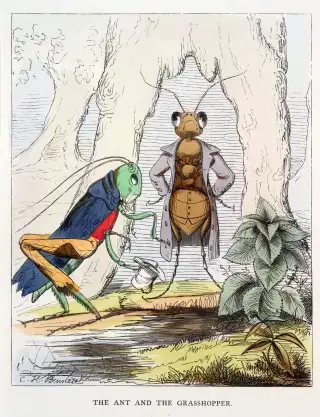All I Want for Christmas: Frugal Kids

A fable that’s frequently invoked when it comes to personal finance is Aesop’s "The Ant and the Grasshopper," in which the ant busily spends his summer storing up supplies for the winter while the grasshopper frolics the warm days away, blissfully ignoring that times of need are around the corner. When the cold days arrive, the ant is warm and well-supplied while the grasshopper is ill-prepared and starving.
The analogy to retirement saving is clear. At a recent conference sponsored by Defined Contribution Institutional Investment Association (DCIIA,) Michael Finke of Texas Tech University pointed out that retirees with the highest wealth spend the lowest percentage of their income in retirement, suggesting that it was their innate ant-like frugality that in part helped them create such a large nest egg -- not just their good fortune or career success. “The ants build up a habit of thrift, and when they reach retirement, they maintain their lifestyle of thrift,” Finke said. “It’s hard to turn an ant into a grasshopper, but you can turn a grasshopper into an ant.”
I was reminded of this recently when my six-year old daughter presented me a three-page-long Christmas list. The items on the list showed the habits of a budding grasshopper: giant teddy bears that had momentarily caught her eye on a recent shopping trip, “newer” versions of some toy that she already had and had long since abandoned. Very few of them were things that she really wanted—she was merely responding to the power of suggestion and, given a blank slate, had dutifully filled it and then some.
Not wanting to send her and her brother down the path of endless grasshopper-like consumption, I offered to instead get them both just one really big thing for Christmas—a trampoline—and nothing else. Even though this purchase would wind up costing me more, I thought it would teach them about trade-offs and spending on something that would hold its value for years. My daughter agreed in theory, but then found herself still wanting a few things from her list—a Christmas dress, the giant teddy bear. And I found myself caught between wanting to fulfill those desires while instilling in them a sense of ant-like restraint. Going through each and every item and debating whether they were really worth it seemed liked a giant buzz-kill on the holiday season.
That’s when a colleague gave me a brilliant suggestion to tell the kids that they can have four things: something they want, something they need, something to wear, and something to read. I was afraid that they might hate the idea, but they both embraced it, in part because it turned list-making into a categorical challenge, a game almost, and it also preserved their freedom to choose. I in turn was pleased because the framework forced them to prioritize desires, forego some things for others, and yes, distinguish wants from needs. (And also accept the fact that clothing and books are legitimate presents.) It wasn’t a completely ant-like solution, but it wasn’t all grasshopper either. I figure I can float the trampoline deal again next year.
Konigsberg is the author of The Truth About Grief, a contributor to the anthology Money Changes Everything, and a director at Arden Asset Management. The views expressed are solely her own.